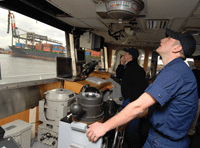Security doesn't stop at the water's surface at Lake Charles Port, La., the largest liquid natural gas port in the country.Underwater sonar, radar and a network of sensors search for threats. The information is then charted into a common operational picture that is shared with nearby agencies, including law enforcement, Coast Guard and immigration officials.The Homeland Security Department listed as a top goal of its port security grants for 2005 protection against improvised explosive devices, and is expected to do so again for the 2006 grant guidance. To guard against such dangers, many ports implement surveillance and intrusion detection systems, which are shared with law enforcement.'It's not gates, guns and guards anymore,' said Aaron Ellis, a spokesman for the American Association of Port Authorities, a trade group for 85 major ports. 'Ports are moving to more sophisticated and technically advanced equipment.'The post-9/11 goals of port security were initially to fence perimeters and install gates, Ellis and others say, but a more recent focus has been on providing a common point of reference and tools for communication among response agencies.Major port security contracts are attracting major systems integrators, including L-3 Communications Corp., Lockheed Martin Corp. and Science Applications International Corp. For example, SAIC won a contract to provide an integrated surveillance system in the Port of Miami. The value of the work was not disclosed.A number of smaller integrators have received port security contracts, too, including Zel Technologies LLC for networked systems at the Port of Norfolk, Va., and Ciber Inc. for harbor security at the Port of Lake Charles.'We competed with all the major defense companies for[the Norfolk port],' said Joe Bouchard, senior program executive for homeland security and maritime security with Zel Technologies of Hampton, Va.'All the major systems integrators compete fiercely for these big port contracts.'Both provide examples of the trends in IT work at ports.At the Lake Charles port, systems integrator Ciber Inc. of Greenwood Village, Colo., installed a harbor management and security system that began operation on May 4. In it, several surveillance systems are integrated into a single wireless network, and linked with vessel and crew information databases to create a common operating picture. That picture is available not only to port officials but to police, fire, Coast Guard, immigration officials and more than two dozen other first response authorities nearby, said Bill Parker, a maritime practice director for Ciber.The information can be geographically customized to each agency's jurisdiction and mission.In Norfolk, a $6 million federal port security grant is paying for a new regional microwave network that links 16 cities and counties and connects them with command centers, Coast Guard and Virginia port authorities, among other agencies.It will establish voice and radio interoperability, provide voice-over-IP telephone capabilities and create a common operational picture for distribution to the communities, Zel's Bouchard said.'Maritime domain awareness is not just cameras and radars. The emphasis is actually on information sharing and being able to share data in real time,' Bouchard said. 'Everyone already has a command center. You need to link them together on a network.'The microwave network will link with Virginia Port Authority surveillance cameras and the Navy and Coast Guard's joint harbor operations center at the Norfolk Naval Port.Since 9/11, many ports have installed cameras and access control systems, but they have gotten a lot more sophisticated about surveillance and intrusion detection in recent months, Ciber's Parker said. Even so, a number of ports still have significant blind spots, he said, adding that the mid-sized and larger ports are moving to install comprehensive systems over wireless networks that extend throughout a region.Port security received a huge boost in attention because of the uproar over Dubai Port World's acquisition earlier this year of a company that managed several U.S. ports. The deal was scuttled after Congress objected to foreign ownership for such national security-related work, though the award had been vetted by the administration.The media attention has led to proposals for increased port security grants to guard against maritime terrorism. The House in April authorized $2.4 billion in such grants to high-risk ports over the next six years'including $400 million in fiscal 2007'but the House Homeland Security Appropriations Subcommittee has approved $200 million in such grants for next year.The grant money can pay for purchasing and upgrading security equipment, including IT products such as video surveillance systems, waterside surveillance vessels, vehicle inspection stations, closed-circuit telecommunications and access-control equipment for the main gate.In addition, the Senate voted in favor of an emergency appropriations bill that adds $227 million to the port security grant funding immediately, up from the $175 million already appropriated for fiscal 2006. However, President Bush has threatened to veto the massive emergency bill, which was initially intended primarily to help fund the war in Iraq.The funding outlook for port security grants has brightened: 'We're cautiously optimistic,' Ellis said. 'The Dubai incident has ... raised the level of awareness.'Ports have been receiving security grants under the Maritime Transportation Security Act of 2002 which, Ellis said, has distributed $708 million to ports. However, the Coast Guard has estimated the cost of protecting port facilities in compliance with the act at $5.4 billion over 10 years. 'Ports are spending millions of dollars of their own money to comply with the act,' Ellis said.
ON PATROL: Coast Guard Petty Officer Cole Chaplin checks the rudder angle, while other crew members survey a Newark Bay, N.J., container terminal during a security patrol this year.







